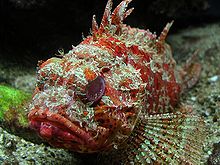Scorpaena scrofa
| Scorpaena scrofa | |
|---|---|
 |
|
| Scientific classification | |
| Kingdom: | Animalia |
| Phylum: | Chordata |
| Class: | Actinopterygii |
| Order: | Scorpaeniformes |
| Family: | Scorpaenidae |
| Genus: | Scorpaena |
| Species: | S. scrofa |
| Binomial name | |
|
Scorpaena scrofa Linnaeus, 1758 |
|
| Synonyms | |
|
|
Scorpaena scrofa, common name the , Bigscale scorpionfish, or large-scaled scorpion fish is a venomous marine species of fish in the family Scorpaenidae, the "scorpionfish".
Scorpaena scrofa is the largest eastern Atlantic scorpion fish. Colouration ranges from brick-red to a light pink, and it has dark coloured blotches on its body. It has venomous spines, can achieve a maximum weight of approximately 3 kilograms (6.6 lb). It can grow to a maximum length of 50 centimetres (20 in), but is commonly around 30 cm (12 in).
It has 12 dorsal spines, 9 dorsal soft rays, 3 anal spines, and 5 soft rays. It often has a dark spot on its spinous dorsal spines between the 6th and 11th. It has long supraorbital tentacles.
This species is found in the Mediterranean Sea. It is also found in the Eastern Atlantic Ocean around the British Isles, where rare, south to Senegal, the Canary Islands, and Cape Verde.
Scorpaena scrofa is demersal and lives in marine, and brackish environments with rocky, sandy or muddy bottoms at depths of 200–500 m (660–1,640 ft). By day, it lives in burrows and caves. At night it comes out to hunt.
This species is a sedentary, solitary and non-migratory fish. It is predatory, feeding on other fish, as well as crustaceans and molluscs.
Scorpaena scrofa is a traditional ingredient in Marseille bouillabaisse. It is also widely used in Japanese cuisine.
...
Wikipedia
